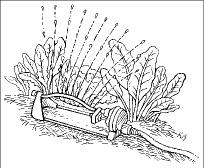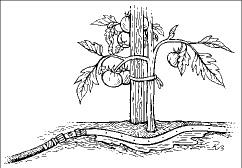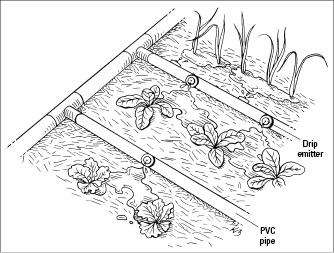Vegetable Gardening (103 page)

 Water is wasted through evaporation as it's sitting in the furrow.
Water is wasted through evaporation as it's sitting in the furrow.
Basins
A
basin
is a donutlike depression around a vegetable plant that you fill with water — almost like a circular furrow. You make a basin in a 2-foot-diameter circle around the plant. Plastic basins that fit underneath plants such as tomatoes and eggplants are sold commercially. These basins concentrate the water around the roots of the plant.
 Homemade basins work particularly well for watering sprawling plants like melons and squash early in the season. After the plants mature, however, their roots grow out of the diameter of the basin, and the method is no longer effective.
Homemade basins work particularly well for watering sprawling plants like melons and squash early in the season. After the plants mature, however, their roots grow out of the diameter of the basin, and the method is no longer effective.
Hoses
Watering with a hose is probably the most common way that gardeners water. It's simple, and some might say therapeutic. Who hasn't seen a gardener after a long day at work come home and take some time to hose down the garden with a cup of coffee or drink in hand?
However, watering with a hose isn't the ideal watering system and probably is best for watering containers; for watering individual, large plants such as tomatoes; and when used in conjunction with the basin method (explained in the preceding section). In these situations, you can be sure that you're applying the right amount of water to your plants.
Unless you check the amount of water you're applying by digging the soil after watering, you may not water your garden evenly with a hose. Some areas may have lots of water, whereas other areas may just have water on the surface. Also, like overhead sprinklers (described in the next section), using a hose is a more wasteful way of watering because much of the water falls in pathways or on the lawn around your garden.
 The best way to water your vegetable garden with a hose is to leave the hose running at a trickle in a basin near each plant until the water has soaked down at least 6 inches deep.
The best way to water your vegetable garden with a hose is to leave the hose running at a trickle in a basin near each plant until the water has soaked down at least 6 inches deep.
Sprinklers
A sprinkler, shown in Figure 15-1, is effective for watering vegetables planted in sandy soil that absorbs water quickly. It's also an effective way to water a large garden when you're pressed for time. Just set up the sprinkler, and based on the amount of time it takes to water to 6 inches deep (see the earlier section "Knowing when your veggies need a drink"), you can set a timer and go about other business. However, if you have heavy clay soil that absorbs water slowly or if your garden is on a slope, the water may run off and not sink into the soil where the plants need it. Instead, it's best to use drip irrigation (see the next section) so the water soaks into the ground.
Figure 15-1:
Watering with a sprinkler.
For vegetable gardens, portable-type sprinklers (versus in-ground permanent sprinklers used in lawns) are best. You can move them around in your garden to cover a certain area or the whole garden. Some sprinklers throw water back and forth, whereas others send it in a circular direction. Choose the type that best suits your garden design.
 Constantly wetting the foliage of vegetable plants can encourage disease problems. So when you use a sprinkler, water in the morning so the foliage can dry before nightfall and so you lose less water to evaporation.
Constantly wetting the foliage of vegetable plants can encourage disease problems. So when you use a sprinkler, water in the morning so the foliage can dry before nightfall and so you lose less water to evaporation.
As taller plants such as corn and tomatoes grow, sprinklers tend to be less effective because the water hits the foliage, damaging it and not thoroughly watering the rest of the garden. Some gardeners use watering towers that have an overhead sprinkler attached to the top. You position the sprinkler a few feet above the plants, hook it up to a hose, and sprinkle the garden. However, even these sprinklers prove to be less effective when plants reach above 4 to 5 feet tall. For these taller plants, it's best to choose one of the other watering methods described in this chapter.
Soaker-hose irrigation
A
soaker-hose irrigation system
consists of a rubber hose perforated with tiny pores that leak water, as shown in Figure 15-2. You can lay the hose between rows or curve it around plants, similar to how you use a drip irrigation system (described in the following section). Water leaks out of the hose and onto the soil, leaving your plant foliage dry and reducing evaporation.
Figure 15-2:
Watering with a soaker hose.
 Using a soaker-hose system is easier than using a drip irrigation system because it involves fewer parts and no nozzles. Its primary limitation is that it works best on flat terrain, often delivering water unevenly on sloped or bumpy gardens. It also may clog over time and not deliver water evenly along the hose.
Using a soaker-hose system is easier than using a drip irrigation system because it involves fewer parts and no nozzles. Its primary limitation is that it works best on flat terrain, often delivering water unevenly on sloped or bumpy gardens. It also may clog over time and not deliver water evenly along the hose.
Drip irrigation
A
drip irrigation system
provides water slowly through holes, or
emitters,
in flexible plastic pipes. Many different drip irrigation systems are available; they can consist of a single pipe with flexible lines running off it, or a series of pipes. You weave these pipes — which are connected to a water supply, a filter, and often a pressure regulator — along rows of plants so the water flows directly to the roots of your vegetables, as shown in Figure 15-3.
Figure 15-3:
Watering with drip irrigation.
This watering technique is the most effective and efficient way to water vegetables because water drips right to the roots of the plants and little water is wasted on pathways, in between plants, and in between rows. Drip irrigation works well even if your garden is on a slope, which poses problems for most other systems.
 The downside to drip irrigation is that it's more costly than the other methods listed in this chapter; it's also more involved to set up and take down at the end of the season. Drip irrigation is best for those gardeners who are into technology, who don't have lots of time to water, and who live in water-restricted areas.
The downside to drip irrigation is that it's more costly than the other methods listed in this chapter; it's also more involved to set up and take down at the end of the season. Drip irrigation is best for those gardeners who are into technology, who don't have lots of time to water, and who live in water-restricted areas.



